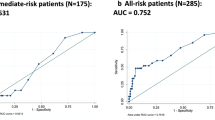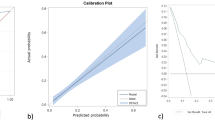Abstract
Introduction
The aim of this study was to compare the performance of preoperative risk nomograms or detecting lymph node invasion in a cohort of men undergoing radical prostatectomy (RP).
Methods
A retrospective analysis was performed on all men (n = 145) who underwent RP between 2012 and 2015. Preoperative data was inputted to the Memorial Sloan-Kettering Cancer Centre (MSKCC), Partin 2011 and Briganti nomograms and the University of California San Francisco- Centre of the Prostate Risk Assessment tool (UCSF-CAPRA). The risk of lymph node involvement (LNI) was calculated and compared to final histology.
Results
One hundred three (71%) men underwent a lymph node dissection at RP. Ten (9.7%) demonstrated LNI. The median nodal yield was 15 nodes, with no difference between those with LNI and those without (19.5 vs 14.5, p = 0.22).No patient classified as low risk on the UCSF-CAPRA score had evidence of LNI. In patients with LNI, no patient breached the 2% threshold for lymph node dissection (LND) on the MSKCC nomogram; four patients breached the 5% threshold on the Partin tables while three patients breached the 2.5% threshold for the Briganti nomogram.
Conclusion
Nomograms produce useful information regarding risk of disease; however, they often have not been validated on different populations. Risk predictions need to be considered carefully and treatment decisions were made on a patient specific basis.
Similar content being viewed by others
References
Heidenreich A, Aus G, Bolla M et al (2008) EAU guidelines on prostate cancer. Eur Urol 53:68–80
Briganti A, Blute ML, Eastham JH et al (2009) Pelvic lymph node dissection in prostate cancer. Eur Urol 55:1251–1265
Masterson TA, Bianco FJ Jr, Vickers AJ et al (2006) The association between total and positive lymph node counts, and disease progression in clinically localised prostate cancer. J Urol 175:1320–1324
Joslyn SA, Konety BR (2006) Impact of extent of lymphadenectomy on survival after radical prostatectomy for prostate cancer. Urology 68:121–125
Heidenreich A, Bastian PJ, Bellmunt J et al (2014) EAU guidelines on prostate cancer. Part 1: screening, diagnosis, and local treatment with curative intent-update 2013. Eur Urol 65:124–137
Graefen M (2006) In which patients with prostate cancer should we perform a lymph-node dissection? Eur Urol 50:278–279
Abdollah F, Schmitges J, Sun M et al (2011) A critical assessment of the value of lymph node dissection at radical prostatectomy: a population-based study. Prostate 71:1587–1594
Briganti A, Chun FK, Salonia A et al (2006) Validation of a nomogram predicting the probability of lymph node invasion among patients undergoing radical prostatectomy and an extended pelvic lymphadenectomy. Eur Urol 49:1019–1026
Cagiannos I, Karakiewicz P, Eastham JA et al (2003) A preoperative nomogram identifying decreased risk of positive pelvic lymph nodes in patients with prostate cancer. J Urol 170:1798–1803
Partin AW, Mangold LA, Lamm DM et al (2001) Contemporary update of prostate cancer staging nomograms (Partin tables) for the new millennium. Urology 58:843–848
Makarov DV, Trock BJ, Humphreys EB et al (2007) Updated nomogram to predict pathologic stage of prostate cancer given prostate-specific antigen level, clinical stage, and biopsy Gleason score (Partin tables) based on cases from 2000 to 2005. Urology 69:1095–1101
Briganti A, Larcher A, Abdollah F et al (2012) Updated nomogram predicting lymph node invasion in patients with prostate cancer undergoing extended pelvic lymph node dissection: the essential importance of percentage of positive cores. Eur Urol 61:480–487
Suardi N, Larcher A, Haese A et al (2014) Indication for and extension of pelvic lymph node dissection during robotic-assisted radical prostatectomy: an analysis of five European institutions. Eur Urol 66:635–643
Kawakami J, Meng MV, Sadetsky N et al (2006) Changing patterns of pelvic lymphadenectomy for prostate cancer: results from CaPSURE. J Urol 176:1382–1386
Schiffmann J, Haese A, Leyh-Bannurah SR et al (2015) Adherence of the indication to Euroepan Assocaition of Urology guideline recommended pelvic lymph node dissection at high volume center: differences between open and robot-assisted radical prostatectomy. Eur J Surg Oncol 4:1547–1553
Heidenreich A, Varga Z, Von Knobloch R (2002) Extended pelvic lymphadenectomy in patients undergoing radical prostatectomy: high incidence of lymph node metastasis. J Urol 167:1681–1686
Walz J, Bladou F, Rousseau B et al (2012) Head to head comparison of nomograms predicting probability of lymph node invasion of prostate cancer in patients undergoing extended pelvic lymph node dissection. Urology 79:546–551
Touijer K, Rabbani F, Otero JR et al (2007) Standard versus limited pelvic lymph node dissection for prostate cancer in patients with a predicted probability of nodal metastasis greater than 1%. J Urol 178:120–124
Abdollah F, Schmitges J, Sun M et al (2011) Head-to-head comparison of three commonly used preoperative tools for prediction of lymph node invasion at radical prostatectomy. Urology 78:1363–1367
de Jong IJ, Pruim J, Elsinga PH et al (2003) Preoperative staging of pelvic lymph nodes in prostate cancer by 11C-choline PET. J Nucl Med 44:331–335
Thoeny HC, Triantafyllou M, Birkhaeuser FD et al (2009) Combined ultrasmall superparamagnetic particles of iron oxide-enhanced and diffusion-weighted magnetic resonance imaging reliably detect pelvic lymph node metastases in normal-sized nodes of bladder and prostate cancer patients. Eur Urol 55:761–769
Winter A, Kneib T, Henke RP et al (2014) Sentinel lymph node dissection in more than 1200 prostate cancer cases: rate and prediction of lymph node involvement depending on preoperative tumor characteristics. Int J Urol 21:58–63
Author information
Authors and Affiliations
Corresponding author
Rights and permissions
About this article
Cite this article
Nason, G.J., O’Connor, E.M., MacMahon, D. et al. Comparison of nomograms predicting lymph node invasion in patients undergoing radical prostatectomy for prostate cancer. Ir J Med Sci 187, 33–37 (2018). https://doi.org/10.1007/s11845-017-1626-8
Received:
Accepted:
Published:
Issue Date:
DOI: https://doi.org/10.1007/s11845-017-1626-8




